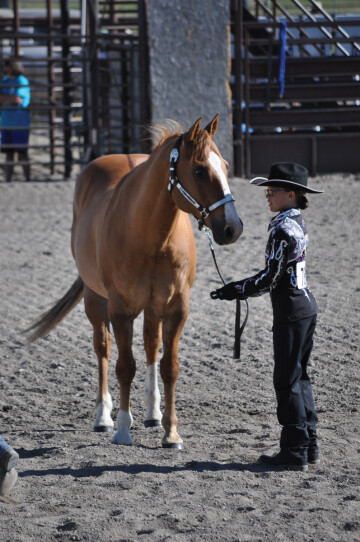Local 4-H Offers Animals & Much More
Robots, Horses & Archery
Heidi Donnelly | Friday Sep. 2nd, 2016
Every summer people all over our country flock to their county fairs to enjoy the rides, foods, entertainment, and a trip through the barns to see the animals. Most of these animals are raised, trained, and shown by local 4-H members who are anywhere from age 5 to 21. What many of us don’t realize though, is that 4-H is much more than animals and agriculture.

Nationally, the 4-H program offers more than 100 projects: animal projects like horse, swine and beef, traditional projects like cooking, gardening and sewing, and other projects like photography, shooting sports, cowboy poetry, and vet science. In Gallatin County, there are over 40 projects offered; one of the fastest growing projects is robotics.
Robotics project leader Gregg Switzer, who has a Ph.D. in laser physics from MSU, has built the project over ten years, designing the robots and challenges himself. What started as nine kids, two Lego robot kits, and a goal to “create engineers that can communicate” has blossomed into 66 kids in two levels and 46 kits.
Switzer has lent his skills on a state and national level as well, offering his experience as support for robotics across Montana and helping write the national 4-H robotics curriculum. He has gained enough notoriety to be invited to speak at a Lego conference in Florida and was granted the opportunity to pilot 7 new kits in his program here in Gallatin County.
“Our classes doubled in size this year,” Switzer said. “I don’t know why, since I didn’t do anything differently.” But the opportunity to build and test robots is hard to pass up.
With that growth, which includes a meeting every Thursday, Switzer finds himself spread pretty thin. He would love to focus on developing the project further. “But I am out of Thursdays,” Switzer said. Even with a parent volunteer and some of his older students helping, he is at his limit.
Kelton Jensen, Gallatin County’s 4-H Youth Development Agent, will tell you that Switzer’s limitations are not uncommon.
“We are always looking for volunteers,” Jensen said. “If there is a hobby or interest that you want to share, there is probably a kid out there that wants to learn about it.” County-wide, 4-H has 130 volunteers and 632 enrolled youth members.
According to Jensen, many of the local projects top the state in enrollment and number of volunteers. However, this year several popular projects lacked leaders well into the 4-H year. Dog agility is an example. They did eventually find a leader, but there was not enough equipment for the kids to compete at fair.
The dog obedience project, however, is thriving. Leader Ron Murray, owner of Montana Murray Kennels in Belgrade, donates his time and business space to the project and has a regular group of volunteers. They all find it well worth it.
“One of the big things about it is what it does for me,” he said of the gratification he gets from watching the kids’ growth. Murray’s passion for the project is easy to see. As for his volunteers, “Their hearts melt when they watch these kids compete,” he said.
The obedience program isn’t the only one benefitting from team work. The pack horse project found a strong partner in the Back Country Horseman, a non-profit organization that promotes back country horse use and works with the Forest Service to keep trails clear. According to project leader Greg Benjamin, it is a mutually beneficial relationship. Benjamin does the organizing, and the Back Country Horseman members bring a strong desire to impart their invaluable knowledge base.
“It got pretty overwhelming before they got involved,” Benjamin said. “They actually do a significant amount of the work.”
Benjamin went on to say that if he needs one person, two will show up, many times with horses and gear. The organization is full of retirees eager to pass their knowledge and passion to the younger generations. On their own, the horsemen were having a hard time attracting the audience. Benjamin was able to bridge that gap and the project is taking off. But their generosity doesn’t stop at their time, animals, and equipment. “They throw money at it, and we have money waiting to be spent,” Benjamin said. It isn’t just their passion for the project and the money that the kids benefit from. Benjamin noted that it is a unique opportunity for the older generation to pass their generational values to the young people.
That is also part of the reason Millie Veltkamp took some initiative when the leaders of the Shining Mountaineers club stepped down. Shining Mountaineers is a legacy club here in Gallatin County; it has been around for generations. It is also currently the only club in Belgrade. After finding the club leaderless, Veltkamp sent an email to club parents saying, “If we all help out, we can see where this goes.” She had about ten parents step up to lead four different teams: community involvement, fundraising, education, and recreation.
According to Jensen, clubs are where the sense of community comes from. “Without the club, you are missing out on the 4-H experience,” he said. The club is ultimately a “like-minded community coming together to learn and serve.”

Gallatin County organizes their clubs and projects differently than most counties. According to Jensen, counties generally run the projects within the clubs. But here they run both the clubs and the projects on a county level. One benefit is that it strengthens the project. For example, they only need one leathercraft leader for the whole county rather than one for each club. That project leader can build a stronger program that every county 4-H member has access to, as Switzer, Benjamin and Murray have done. But members aren’t just learning from their projects.
Veltkamp credits 4-H with much of the significant growth in her own children; she sees 4-H as an asset to children and families in our county. “The life skills these kids are learning are incredible,” she said. “Our treasurer is ten (years old); the kids on these committees get to make decisions.” She went on to highlight kids she sees at the beginning of the year who struggle to introduce themselves at meetings and then go on to give speeches at the county communication day.
And, the kids are supportive of one another. “They are competing, but also celebrating each other’s successes,” she said. “It isn’t like the direct competition you see in sports.”
Veltkamp’s children have been involved in woodworking, archery, robotics, quilting, baking, dog obedience and agility, and sport fishing. All those projects had leaders except woodworking and sport fishing. Woodworking turned out to be an opportunity for her son to learn from his woodworking grandfather.
“Lots of projects you can do without a leader,” she said. “But a leader keeps you motivated and on track to complete the project. Plus, with other kids it adds an element of excitement.”
Any state that has a land-grant university has an extension service designed to pass any research knowledge from the universities to the communities. But early on, adults were not open to new ways and ideas, which is where 4-H came in. “If the adults didn’t want to try the new technology, they taught it to the kids,” Jensen said. And, after the kid’s corn field yielded more than his dad’s field, it was hard to ignore the research.
The local 4-H program is always looking for new leaders for both clubs and projects, even for those that seem to have plenty of help. Shooting Sports leader Scott Francis works with about 25 volunteers helping with eight projects, including archery, air rifle and pistol, shotgun and western heritage. “It is definitely a teamwork thing,” he said. “We rely on each other to make it work.” The project has also teamed up with Gallatin Valley Sharp Shooters, sharing a facility, equipment, and manpower. But with 150 members in the project, there is always room for more volunteers.
When asked how many clubs there were in the county, Jensen replied, “Not enough.” In Manhattan alone there are three clubs, but Bozeman has two, and Belgrade only has one. “Our best clubs have multiple leaders,” Jensen said. He pointed to Veltkamp and her efforts to keep Shining Mountaineers going with the teams she has assembled. “It has been working great for them,” he said. The same can be said for the packing, dog obedience, and shooting sports teams.
According to Jensen, the organization that 4-H gets compared to most is scouts. But he pointed out that while scouts offer strong programs, they cannot compare to the variety and uniqueness that 4-H offers with all its projects. Joining is also very affordable: $20 to become a member and $1 per project.
The 4-H year starts October 1. For more information on how to volunteer with the Gallatin 4-H program or how to get your children involved, call the Gallatin County Extension office at 406-388-3213 or visit www.gallatin4h.org
| Tweet |
